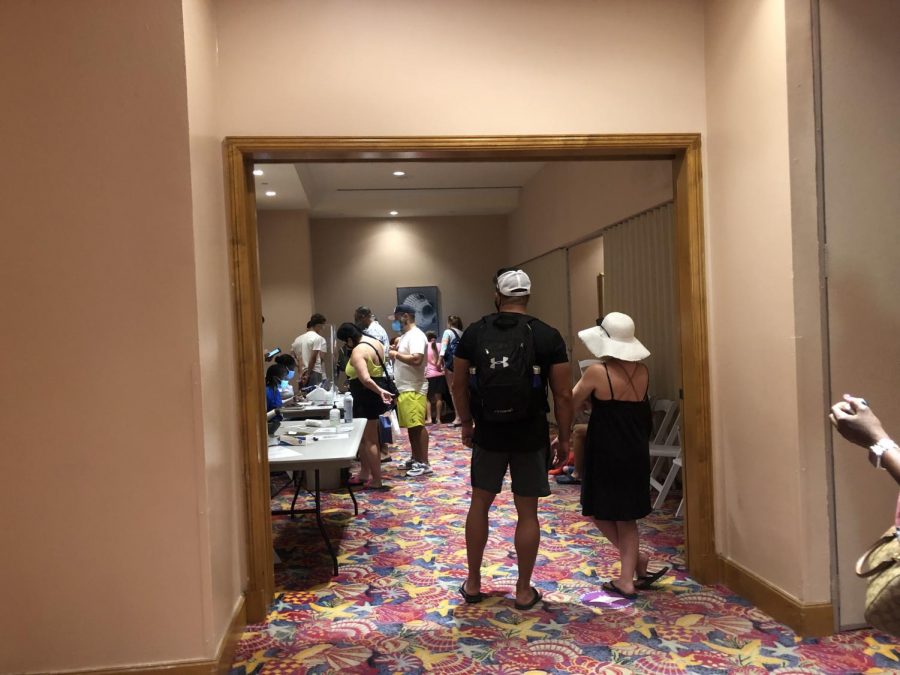Traveling during a COVID-19 summer: Year two
Credit: Tess Alongi
Many wait in line to get COVID-19 tested. The US requires people returning from international locations to show proof of a negative COVID-19 test before arrival.
September 1, 2021
Summer 2021 marks the second summer with COVID-19 restrictions and precautions in place. With COVID-19 vaccinations available, many anticipated that this summer would be a lot more normal. But, with the delta variant present, this summer didn’t live up to the expectations of many. Many people still opted to go on vacations, entailing many steps that needed to be taken.
Various countries required COVID-19 testing to travel out of the country and to return home. Different countries had different rules when it came to testing and traveling for unvaccinated people. Junior Hannah Gordon went to Costa Rica at the beginning of July for two weeks, and even though she was vaccinated, she still got tested multiple times.
“I had to do a health pass form and get tested before I went [to Costa Rica],” Gordon said. “I got tested twice during my trip, and I had to get tested before I came home. A negative test was required to reenter the [United States].”
Junior Lila Powers also traveled internationally, and, like Gordon, she got tested before she left. Although both Powers and Gordon got tested, the rules for who needed to get tested were different depending on the location of travel.
“I went to Aruba from the end of July to the beginning of August,” Powers said. “In order to go on the plane and enter Aruba, everyone 15 and older had to get PCR tested at a drive-through COVID-19 testing site. Before coming home, everyone [including those under 15] had to take a PCR test to get back into the United States.”
When it comes to traveling domestically, the rules are different. Freshman Zoe Roi stayed within the country, going to Hawaii, and the COVID-19 protocols were different from those who traveled internationally. If you are fully vaccinated and flying within the United States, you do not need to get COVID-19 tested at any point of your trip.
“We didn’t need to do anything related to COVID-19 [testing], except have proof of vaccine cards and fill out a form related to our vaccines,” Roi said. “One reason we chose Hawaii was because it wasn’t out of the states, and the COVID-19 rates there are very low.”
When it came to COVID-19 protocols on the islands, the rules varied. In Hawaii, masks were mandatory inside but optional outside. However, in Aruba, masks are not required inside.
“When we were in Aruba, mask-wearing was encouraged but not mandatory,” Powers said. “A lot of people didn’t wear masks, and we were outside almost all of the time. During the trip, we wore masks when we were inside anywhere.”
Last year, many families avoided the airport during their travels as the summer fell during only the first few months of COVID-19, and governments still recommended flying only for emergencies. Even though COVID-19 is still very present, many families who didn’t travel by plane last year did this year.
“I did travel last summer, but I didn’t fly anywhere,” Gordon said. “My family and I only went places that we could drive, like [Cape Cod] and Maine. I felt safer this year because I was vaccinated.”
Being more comfortable with traveling during COVID-19 while being vaccinated is something that both Powers and Roi agreed on.
“Last summer I traveled but not on a plane,” Powers said. “It did feel better now that a lot of people are vaccinated, but there was also a little worry with the delta [variant].”





![Last Wednesday, the Wayland School Committee gathered to discuss a number of topics regarding the health curriculum and Innovation Career Pathway course. Another large topic of conversation was the ways to potentially mitigate distracting cell phone usage. "These [phones] are going to distract your learning and social relationships," Superintendent David Fleishman said. "That's concrete right there."](https://waylandstudentpress.com/wp-content/uploads/2025/06/Screenshot-2025-06-04-at-9.49.31 PM-1200x886.png)



























![Troy Hoyt finishes the Boston Marathon, running for the Hoyt Foundation. T. Hoyt is the son of Hoyt Foundation CEO Russ Hoyt.
“[Running a marathon] might seem like a big thing, when it’s presented to you at first, but if you break it up and just keep telling yourself, “Yes, you can,” you can start chipping away at it. And before you know it, you’ll be running the whole 26 miles, and you won’t even think twice about it.” T. Hoyt said.](https://waylandstudentpress.com/wp-content/uploads/2025/04/C36E8761-1CBB-452E-9DF2-543EF7B1095E_1_105_c.jpeg)













































